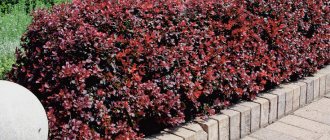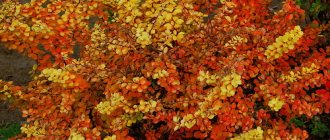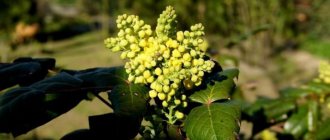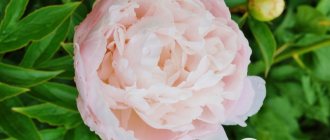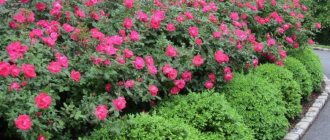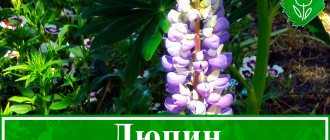Author: Elena N. https://floristics.info/ru/index.php?option=com_contact&view=contact&id=19 Category: Garden plants Published: February 20, 2019Republished: November 17, 2021Last edits: November 17, 2021
- Growing conditions
- Reproduction methods
- Preparation
- Common barberry (Berberis vulgaris)
- Beneficial features
plant (lat. Berberis) belongs to a large genus of shrubs and trees of the Barberry family. The genus name comes from the Arabic "beiberi", meaning "shell-shaped". Barberries are widespread mainly in the mountainous areas of the Northern Hemisphere and number about 170 species, some of which have been introduced into cultivation. For gardeners, barberry is of interest as a raw material base for the production of drinks, jams, home remedies, but the decorative qualities of this plant do not go unnoticed by lovers of beauty - the color of the leaves of varietal barberries is varied, in addition to green, they can be yellow, purple, variegated, spotted and even with border. Barberries also differ in size - from large bushes three meters high to dwarf bushes no higher than 30 cm.
Planting and caring for barberry
- Planting: if necessary, in the fall, during leaf fall, but best in the spring, as soon as the snow melts.
- Lighting: bright sunlight or partial shade.
- Soil: neutral, composition does not matter much.
- Mulching: desirable.
- Watering: in a season with normal rainfall, barberry does not require moisture, but if there is a drought, water the plant once a week at the root. Newly planted bushes also need weekly watering.
- Feeding: a year after planting and then every 3-4 years in early spring, the plant is fed with nitrogen fertilizers, and after flowering and in the fall - with potassium-phosphorus fertilizers.
- Pruning: the first time the procedure is carried out in the spring on a one-year-old bush, then barberry is pruned twice a year for sanitary purposes and to form a crown: in the first half of June and in early August. The crowns of low-growing species and varieties need not be formed.
- Reproduction: by seeds and vegetatively: layering, dividing the bush and cuttings.
- Pests: barberry aphids, sawflies and flower moths.
- Diseases: rust, powdery mildew, bacteriosis, wilting, drying out of shoots and leaf spotting.
Read more about growing barberry below.
Shrub Barberry Thunberg in landscape design
The plant can be used as a focal planting, but they are most often grown as a hedge or in a group planting. Timely, proper pruning can form shrubs into a low border hedge along garden paths.
This Japanese Barberry looks great both in group compositions and in single ones.
Plant red barberry at the back of your flowerbed to create a colorful backdrop for smaller flowers and annuals. The Berberis thunbergii cultivar 'Atropurpurea' will bring contrasting colors to the summer landscape with its red or purple leaves. Dwarf or compact varieties (Admiration or Atropurpurea Nana) can be used to plant along a patio or to create a natural edge to a flowerbed.
Also, crops often complement Japanese gardens well; for this, choose specimens with a dense crown. If you don’t know what to plant next to Barberry, pay attention to Boxwood or coniferous crops. For example, it goes well with blue spruce, forsythia, euonymus or thuja.
Botanical description
The barberry shrub is a deciduous, evergreen or semi-evergreen thorny plant with alternate, simple, and sometimes leathery leaves. Barberry spines are modified leaves, of which only the midrib remains. In the axil of the thorn, such short shoots develop that the barberry leaves grow in the form of bunches. On the current year's shoots, the leaves are arranged in a spiral, singly. Barberry flowers are small, fragrant, yellow-golden or orange with red hues included - usually collected in a corymbose or racemose inflorescence, but sometimes they are solitary. Each petal has two nectaries.
The smell of blooming barberry attracts bees - barberry is an excellent honey plant. Barberry fruits vary in color and shape, which depend on the type and variety of the plant. Barberry tolerates urban conditions well, any soil is suitable for it, it is drought-resistant and completely unpretentious. Barberry is the best shrub for a hedge.
Description of the shrub plant Barberry Thunberg
The genus Berberis includes about 450 species of bush plants native to temperate and subtropical regions of Europe, Asia, Africa, and North and South America. Barberry Thunberg is one of the most famous and quite popular varieties of this genus.
In everyday life you can find other names for this species - Japanese barberry or red barberry. This species is native to Japan and East Asia.
A deciduous shrub that grows in nature up to 0.9-1.8 m in height, with a very dense rounded crown. The branches are curved, thin, zigzag, bearing one sharp thorn at each node under each rosette of leaves. Single spines are usually 1-1.5 mm long (some varieties do not have spines). The leaves are alternate, formed in clusters, oval, 1.3-3.2 cm long, of various sizes, with a narrow base, from green to reddish or purple in color.
Tiny fragrant yellowish flowers (up to 1 cm wide) appear towards the end of spring on a long stalk, but they are not as showy compared to the beauty of the foliage. They form pendulous clusters along the undersides of the branches. In autumn, after flowering, you can expect a bountiful harvest of bright red berries (up to 3 cm). The fruits are well preserved until winter.
The berries of Barberry Thunberg are considered inedible. The fruits contain alkaloids that give them a bitter taste and which can be harmful to the human body.
Planting barberry
When to plant
Barberry is most often planted in the spring, as soon as the soil thaws, but you need to have time to plant the seedlings before the buds open. In rare cases, barberry is planted in the fall, during the period of mass leaf fall. Due to the unpretentiousness of barberry, it can grow in open areas, since it is not afraid of drafts and strong winds, as well as in partial shade, but under the bright sun, varieties and species with purple leaves look brighter. As for soil acidity, barberry prefers neutral soils, but can easily withstand soil with a pH no higher than 7.
- Foxglove: growing from seeds, types and varieties
If the soil on the site is very acidic, it needs to be limed. This can be done in advance or directly during planting by pouring into the planting hole a mixture of 8-10 kg of humus or compost and garden soil, 100 g of superphosphate, 400 g of slaked lime and 200 g of wood ash.
How to plant
When planting alone, the distance between the bushes is kept from one and a half to two meters, but if you decide to plant a barberry hedge, then two bushes are planted per linear meter. The size of the holes for seedlings, which need to be dug 2-3 weeks before planting, is approximately 40x40, and a trench for a hedge is dug about 40 cm deep. To increase the aeration of the roots, a layer of sand is poured onto the bottom of the trench or each hole.
If the pH value of the soil is slightly shifted towards the alkaline side, neutral or slightly acidic, then the mixture, the composition of which is indicated in the previous section, but without lime and ash, is poured into the hole before planting. Then a barberry seedling is lowered into the hole, sprinkled with soil, compacted, watered abundantly, and then the tree trunk circle is mulched with peat or compost. After planting, the above-ground part of the seedling is cut off, leaving only a part with 3-5 well-developed buds.
How to choose a barberry seedling
You can buy barberry seedlings in various garden centers, nurseries, specialized stores, and summer cottage online stores. There is a significant advantage to purchasing a product “in person”: you can immediately see the product and choose the best option.
Barberry planting material can be of two types:
- Saplings with an open root system (ROS) . Its roots are found outdoors outside the ground. It is advisable to plant it immediately after purchase; if this is not possible, then you need to dig it into the soil or dip it in a clay mash (for transportation), the roots should not dry out. An OKS seedling is cheaper, but it takes root less well, and during the time after purchase and before planting, the roots can be injured and dry out. An example of a seedling with an open root system in the photo:
- Barberry seedlings with a closed root system (ZKS) . The roots of such seedlings are located in the ground in a container (container, pot). This option is much better than the first, because such seedlings take root faster and better, but they are more expensive. An example of a ZKS seedling in the photo below:
How to choose a ZKS seedling
The following tips will help you choose a high-quality barberry seedling with a closed root system:
- The best ZKS seedling is the one that stays in its pot for a long time . You should not buy a ZKS seedling that has recently been transplanted into this container. The fact is that it is unknown for what reasons it was transplanted into a new container; it is quite possible that the seedling was in critical condition (the roots could have been exposed to the open air for a long time, the roots could have rotted). You can make sure that it has not recently been replanted by performing a number of manipulations: Lift the pot and inspect the drainage holes. The roots should be visible in them (but not stick out too much), this means that the plant has been in this container for a long time.
- Gently grab the plant by the trunk and pull lightly, it should sit firmly in the substrate. If a small shrub easily climbs out of the ground, and the soil itself is loose and crumbly, then most likely it was recently replanted.
- If some small weeds grow in a pot, it means that the seedling has been in this container for a long time.
- There should be no moldy smell coming from the clod of earth and the plant itself. Also around the drainage holes, there should be no traces of mold on the substrate.
- The leaves should be elastic and healthy. If they are withered, lethargic, dry, or affected by diseases or pests, then, of course, it is not worth buying such a specimen.
- The shoots of the seedling must also be healthy and elastic. Under no circumstances should the branches be dry or broken.
How to choose an OKS seedling
Although the option with a seedling with an open root system is less preferable, it is easier to carefully inspect it before purchasing! The OKS seedling must meet the following requirements:
- The root system should be well developed, have a powerful central root, and have additional adventitious roots.
- The roots should be healthy and elastic. You should not buy the option with overdried, damaged, rotten, moldy roots.
- There should be no moldy smell coming from the root system.
- The shoots and leaves of the seedling, also those of the seedling with PCD, must be healthy and elastic.
Barberry care
Growing conditions
Even a novice gardener can plant and care for barberry, and it doesn’t really matter what species it belongs to, since planting and caring for Thunberg barberry, for example, which is a purely decorative species due to its too bitter fruits, is not much different from caring for for species bearing edible berries. So, once you have learned the instructions for caring for barberry, you can grow barberry in the garden of various varieties, types and shapes.
The list of necessary work for caring for barberry includes timely watering, weeding, loosening the soil on the site, pruning and fertilizing.
There is no need to water barberry when there is a normal amount of precipitation, and only in extreme heat and drought, the soil in the area with barberry still needs to be moistened weekly - with cool water at the root, trying not to get on the leaves. Newly planted bushes are watered with the same regularity until they take root. What is more dangerous for barberry is not dryness, but frequent and heavy rains, due to which moisture can accumulate in the roots, which the plant fears much more than drought.
Promptly remove weeds from the area, as well as root shoots that grow abundantly around barberry bushes, and do not forget to loosen the soil. To make caring for barberry easier, mulch the area with peat, sawdust or walnut shells.
Fertilizer
Fertilizers added to the soil when planting will last the barberry for a year. Next spring, each barberry bush is fed with nitrogen fertilizer in the form of a solution of 20-30 g of urea in a bucket of water. From now on, it will be enough to apply nitrogen fertilizers once every three to four years, but if you grow barberry for its healthy edible berries, then after flowering and at the end of the season you need to feed the bush with phosphorus and potassium - 10 g of potassium fertilizer and 15 g each superphosphate for each bush.
The optimal complex fertilizer for barberry is the Kemira-universal solution, which is applied in early July at the rate of 15 g per bucket of water.
Trimming
Like other garden shrubs, when pruning barberry, weak, dry shoots that thicken the bush are removed. The first pruning of decorative barberry species is carried out in the spring on a one-year-old bush, shortening the shoots by half or even two-thirds; then the bush is pruned twice a year - in the first half of June and in early August. In addition to its sanitary function, pruning also has a formative meaning. Low-growing varieties and types of barberry do not need to be cut.
Pests and diseases
Among the harmful insects, the plant can be affected by barberry aphids, barberry sawflies and flower moths. The appearance of aphids is detected by wrinkling and drying of the leaves, and the moth is more dangerous for barberries with edible berries, since it eats away the fruits. Aphids can be fought with a solution of laundry soap (300 g of soap per 10 liters of water), and moths, like sawfly caterpillars, are poisoned with a one to three percent solution of Chlorophos.
Among the diseases, barberries most often suffer from fungal diseases, including powdery mildew, rust, bacteriosis, leaf spot and wilt.
Powdery mildew looks like a white loose coating covering the leaves, shoots and fruits of barberry. By autumn, cleistothecia form on the affected areas, in which the fungus survives the winter. Powdery mildew can be destroyed by treating the plant with a one percent solution of colloidal sulfur; severely affected parts of the plant must be removed and burned.
- Tigridia: cultivation and care in the garden, types and varieties
Rust usually appears on barberries growing near fields with cereals, and looks like bright orange spots on the upper side of the leaf blade, and on the underside it appears as convex red pads. If the infection is severe, the barberry leaves begin to dry out and fall off. You can eliminate the problem by treating barberry three times with one percent solutions of colloidal sulfur or Bordeaux mixture, starting immediately after the leaves bloom and every three weeks.
Barberry can be eliminated from spots that disfigure leaves with spots of various shapes by treating with copper oxychloride, diluted in an amount of 30-40 g in 10 liters of water, applied before and after flowering.
Wilting causes premature lethargy and drying out of the leaves and shoots of barberry, gradually spreading from one side of the bush to the entire plant. Timely removal of diseased shoots can prevent the disease from spreading to the entire bush. If the disease is detected in a timely manner, treating the bush with Bordeaux mixture or copper oxychloride helps cure the plant. As a preventive measure, spring treatment of barberry with Bordeaux mixture is used.
Bacteriosis is a bacterial cancer that manifests itself on barberry with cracks, tumors and growth. If the tip of the shoot is affected by bacteriosis, this is not so bad - remove the affected part of the shoot, capturing healthy tissue. But if cancer affects the shoot in its lower part adjacent to the trunk, the entire plant is doomed. Remove diseased areas of barberry, be sure to burn them, and treat the bush itself with Bordeaux mixture or other copper-containing preparation.
What fertilizers are suitable for barberry
In order for the bushes to delight the owner with a riot of crown colors, produce a bountiful harvest and bloom luxuriantly, it is necessary to feed them with vitamins and microelements. They will give the plant a stimulus for growth and protect it from pests.
Organic fertilizers
The first portion of fertilizer is placed in the hole when planting barberry. The soil is mixed with turf soil and humus. The top is fertilized with peat. This feeding helps the shrubs to quickly take root, nourish them with microelements and protect them from the harmful effects of bad weather and insects.
Further, organic nutrition is given to the plant in the fall, after the growing season, once every 3 years.
It is important! Never put fresh manure into the hole. The roots of the plant will get burned and it will die.
Mineral fertilizers
They are used to fertilize barberry for the 4th year of life, provided that the planting was carried out according to the rules and the bush received all the necessary microelements. Since the first few years are spent adapting and strengthening the root system. For this, the plant needs nitrogen. In the spring, barberry is fertilized with urea or ammonium nitrate.
Phosphorus fertilizer is applied closer to summer or autumn. Spring feeding with potassium helps strengthen the kidneys. Mineral fertilizer for barberry is a necessary fertilizer; when spring comes, the plant will give a lush color and a bountiful harvest of fruits.
Complex fertilizers
It is also necessary to feed the plants in the summer, because feeding is important after the rapid flowering of barberry in the spring. Ready-made microelements do not require additional effort - just follow the instructions on the manufacturer’s packaging. Plants will receive the necessary, balanced set of vitamins and microelements.
Scheme and timing of spring feeding of barberry
The spring dose of microelements is vital for plants; fertilizing for barberry is introduced throughout all three months in the spring, and in the summer it is enough to simply water it.
- the first stage begins somewhere in mid-April, when there are no longer severe frosts, and the plant is preparing to release buds. They feed the bushes with potassium, phosphorus and nitrogen;
- the second stage is during the formation of buds, 10 days before flowering. During this period, it is very important for barberry to receive microelements - fertilizer stimulates the development of buds, strengthens them, and spring becomes a period of lush flowering;
- the third stage is carried out at the end of spring, when the plants have bloomed. This spring feeding is necessary for barberry, which is grown for harvest and
Shrubs grown for berry picking are fed according to this scheme every year. For decorative varieties, it is enough to carry out the procedure once every 3-4 years.
Goals and objectives of spring feeding
Spring is a time of intensive growth, flowering, and fruit formation for all plants. Barberries are no exception. For these processes to be beneficial, the bushes must be fed with fertilizers. Also, feeding barberry in the spring, with the correct use of microelements, strengthens the immune system and protects against pests. Goals of spring feeding:
- saturate the soil with useful substances to improve vegetation processes;
- accelerate the growth of shoots and buds;
- maintain a rich and healthy appearance of foliage;
- increase the number of ovaries to obtain a bountiful harvest of berries;
- develop plant resistance to weather anomalies.
Barberry propagation
Reproduction methods
Reproduction of barberry is possible in a generative way, that is, by seeds, and vegetatively - by cuttings, layering and dividing the bush. Each of these methods has its own advantages and disadvantages, but having information about each of them will make it easier for you to make a choice.
Growing from seeds
Collect ripe barberry berries, separate the seeds from the fruit pulp, hold them for several minutes in a solution of potassium permanganate, and then dry. In the fall, the seeds are sown directly into the soil of the training bed to a depth of 1 cm; in the spring, after the appearance of two true leaves, the seedlings are thinned out so that there is a distance of at least three centimeters between them. Seedlings are grown in a training bed for two years, and then transplanted to a permanent place.
If you decide to sow barberry seeds in the spring, then you will first have to stratify them - mix the seeds with sand and keep them for two to five months in the refrigerator at a temperature of 2-5 ºC. Barberry seedlings transplanted to a permanent place bear fruit 2-3 years after germination, but only if the barberry at the dacha is represented by not one, but several bushes - barberries bear fruit only with cross-pollination.
Propagation by cuttings
Barberry cuttings are cut in mid-June early in the morning. The lower leaves are removed from the segments, and the upper ones are shortened by half. The cuttings are dipped for several hours in a solution of a root former - Epin, Kornevin, heteroauxin, then they are washed in water and planted in a greenhouse in a moist substrate of approximately the following composition: one part each of humus, fertile soil and peat with the addition of half a part of sand. Build a transparent, removable dome for the greenhouse in which the cuttings will stay for about two weeks. The lid is lifted from time to time to ventilate the cuttings, and after they have rooted, they are removed completely. Cuttings of barberry also involve growing seedlings in a training bed for two years until transplanting to a permanent place.
Reproduction by layering
In the spring, select a strong annual shoot from the lower branches of the bush, bend it to the ground, place it in a pre-made groove about 20 cm deep, secure it in it and fill the groove with earth, leaving only the top of the shoot on the surface. By autumn, the cuttings will take root, and you will have ready-made seedlings that will need to be transplanted and grown.
Dividing the bush
This method is good for short plant species that have reached three to five years of age, in which the root collar is buried at least 10 cm. In the spring, dig up the bush and cut it into several approximately equal parts. You may have to use a pruning saw in addition to the pruning shears to separate the barberry root, but proceed carefully, being careful not to injure the plant too much. After dividing the bush, treat all sections with crushed coal and plant the divisions. If the shoots on a barberry begin to branch above the soil level, it should not be propagated by dividing the bush.
Goals and objectives of spring feeding
The main goal of spring feeding of barberries is to create the most comfortable conditions for active growth, abundant flowering and high-quality fruiting of shrubs, as well as successfully overcoming diseases and the effects of negative environmental factors.
Problems solved in the process of achieving the main goal of fertilizing barberry:
- Restoration of soil reserves of microelements necessary for normal vegetation of bushes.
- Increasing plant resistance to changing environmental conditions.
- Stimulating the growth of new healthy shoots on bushes.
- Increasing the number of full-fledged ovaries in varietal varieties grown to produce edible fruits.
Barberry in winter
Preparation
With the onset of deep autumn, the tree trunk circles around the barberry are mulched with loose material - peat, compost or dry leaves.
Wintering
Young barberry up to the age of five should be covered with spruce branches for the winter, especially evergreen species. If the barberry bush is too voluminous, it is covered for the winter in the same way as garden roses or hydrangea: the branches are tightly tied with twine or rope, a cylinder is built from a metal mesh around the barberry, the height of which is 10 cm greater than the bush, and dry soil is poured into the gap between the bush and the mesh. foliage, and then the cylinder is wrapped with covering material.
Mistakes gardeners make when applying fertilizers
In order for a bright barberry bush to please the eye in the warm season, you need to follow simple rules and avoid mistakes when caring for the plant. Here are the most common of them:
- the plant is fertilized during frosts or in extreme heat;
- incorrect selection of drugs or overdose;
- violation of the timing of feeding for young or immature plants;
- expired or spoiled fertilizer due to improper storage.
Care for barberry correctly by following the tips in this article. By spending a minimum amount of time, you will get maximum pleasure from a bright, lush and healthy plant on your site!
Types and varieties
The sheer number of species and varieties of barberry can be confusing, especially since they are all incredibly attractive. When choosing, you should focus on what goal you are pursuing. If you are interested in edible barberry berries, then some types are planted for this, but if you want the plants to decorate your garden or become a picturesque hedge around the site, then there are others for this. But there are species and varieties that can successfully cope with both tasks.
Common barberry (Berberis vulgaris)
The main species of the barberry genus. This is a shrub up to three meters high with gray-brown shoots, on which tripartite spines up to 2 cm long grow. The leaves are elliptical, thin, membranous, with ciliated-serrate edges, the upper side of the leaf plate is dark green, the lower side is dull, gray. green. The racemose inflorescences, up to 6 cm long, consist of brilliant yellow fragrant flowers that bloom for two to three weeks. Numerous bright red fruits reach a length of one and a half centimeters.
- Planting flowers in autumn
This species has a large number of varieties - albo-variegata with white-variegated leaves, aureo-marginata with leaves edged with a golden rim, barberry atropurpurea with red or dark purple leaves. And the berries of the seedless form of barberry asperm are very convenient to process.
There are a number of species similar to common barberry: Provençal barberry (a hybrid of common barberry and Siberian barberry), spinous - a species from the Himalayas, Canadian, Zimbold's barberry, James's barberry and Diels' barberry.
Thunberg's barberry (Berberis thunbergii)
The most beautiful of the deciduous barberries, the champion of the genus among ornamental species. The height of Thunberg barberry is from 50 cm to 1 m, its branches extend horizontally, yellowish or bright red young densely branched shoots are arched, with age they become brown or purple-brown. The spines, 1 cm long, are very thin and elastic. The leaves are elegantly shaped - oblong or obovate, small - no longer than 3 cm, bright green above and bluish below, turning bright red in autumn. Single or clustered flowers, red on the outside of the petals and yellow on the inside, bloom for one to two weeks. Coral-red shiny elliptical fruits up to 1 cm long ripen in early autumn and decorate autumn and even winter bushes for a long time.
The berries of this species contain many alkaloids and therefore taste bitter, but they are an excellent food for birds in winter. Planting Thunberg barberry and further caring for it does not cause any trouble, but the aesthetic pleasure that you will get by growing this species or its varieties on your site is beyond all expectations. Thunberg's barberry has several decorative forms: multi-flowered (pluriflora), dark purple (atropurpurea), silver-marginated (argenteo-marginata) and others. Popular varieties:
- barberry Golden Ring up to three meters high with a rounded crown, ovate leaves up to 4 cm long, dark purple-red in color with a yellow border along the edge. In autumn the leaves take on an intense red hue. The flowers, collected in bunches of 2-5 pieces, up to 1 cm in diameter, are yellow on the inside and red on the outside. Coral-red, shiny berries ripen in October;
- Red Pilar barberry is an attractive columnar-shaped variety up to one and a half meters high and a crown width of up to 45 cm with reddish-purple leaves that turn bright scarlet in autumn;
- barberry Orange Rocket is a columnar-shaped variety, reaching a height of no more than 120 cm and a width of 60 cm. Small smooth ovoid leaves on the current year's shoots are orange with a yellow border, the leaves on last year's shoots are red-purple - the bush looks incredibly attractive against the backdrop of spring and summer greenery. In autumn the leaves turn different shades of red;
- Kornik is a deciduous shrub, one and a half meters tall, with pale green leaves covered with random creamy-white spots of various shapes, as if splashed with paint. In autumn, the green background of the leaves turns scarlet red. The variety looks great next to roses, conifers and other varieties of barberry.
Ottawa barberry (Berberis x ottawensis)
It is an ornamental hybrid between the atropurpurea form of common barberry and Thunberg barberry. This is one of the most spectacular representatives of the genus: from one and a half to two meters in height, it looks like an enlarged copy of the Thunberg barberry, but the color of the leaves is closer to the purple-leaved form of the common barberry - dark pink-violet, almost black in the sun, color. In autumn, the leaves turn crimson and blaze for a long time in a joyless gray garden.
Ottawa barberry is winter-hardy, easy to care for and grows very quickly. Popular varieties:
- Auricoma - up to 2.5 m high, rounded leaves, up to 5 cm long, bright red in spring and summer, orange in autumn, red-yellow flowers up to 1 cm in diameter collected in racemes up to 5 cm long, bright red fruits;
- Superba - up to 4 m high, leaves are round, 3 to 5 cm long, dark red with a bluish bloom, in autumn they turn into various shades of orange and red. Yellow-red flowers are collected in clusters, the berries are red;
- Silver Miles - This variety needs to be viewed from afar as it doesn't look attractive up close: purple leaves with dirty gray smudges. From a distance, the bush acquires a lilac hue due to the fusion of gray and purple flowers.
In addition to the listed types of barberry, Juliana, Bean, Tischler, Morrison, Wilson barberries, greenish, willow, multi-flowered, oriental, Iberian, reticulate, similar, bluish-white, boxwood, notched or unedged, large-thorned, provincial, spring are grown in culture around the world , Ili, coin, Korean, Tibetan, Siberian, transparent, round-serrated, twisted, Amur, Turkmen, whole-edged, oblong, round-fruited, Asian and many others.
Carrying out proper pruning
Berberis thunbergii is the most beautiful of all varieties of deciduous barberries and is rightfully considered the champion among ornamental varieties used in home landscape design. The plant grows quite easily and is absolutely not afraid of pruning, so it is widely used both in single plantings and when creating hedges.
Pruning of Berberis thunbergii bushes should be done in late autumn or early spring, even before the mass appearance of leaves on the plant. First of all, it is necessary to remove all dry branches, as well as those damaged by frost and disease. Barberry is quite easy to form, so the ornamental shrub can be given almost any shape. Berberis thunbergii is very often used for topiary.
Barberries are capable of growing strongly due to the active formation of basal shoots. As a result, a significant number of trunks are formed, which involves the removal of all young shoots, of which it is advisable to leave no more than a couple of the most developed ones. Cutting into a ring, as well as removing old branches that thicken the crown, not only improves the appearance, but also contributes to partial or complete rejuvenation of the plant.
The upward direction of growth allows for decorative pruning of barberry bushes, as a result of which the crown can take on a pyramidal or spherical shape. Formative haircuts must be carried out in the spring, after sanitary pruning. Formative cutting is required from the second or third year of the plant’s life.
Properties of barberry
Beneficial features
The decorative advantages of barberry have attracted the attention of gardeners to this plant, but it makes sense to grow barberry in your garden not only because of the beauty of the leaves, flowers and berries, but also because of their medicinal and taste qualities. In this sense, the most popular species is the common barberry, which is grown primarily not as an ornamental plant, but as a berry bush, from the fruits of which jelly and compotes, syrups, liqueurs, jams, marinades, jellies and marshmallows are made. In Armenian cuisine, pickled barberries are served with fried vegetables, lamb and rice.
The berries of edible barberry species contain tartaric, malic and citric acids, and the leaves contain vitamins E and C, as well as carotenoids and mineral salts. Various properties of barberry can lower blood pressure, kill infections in the intestines, cope with psoriasis, stop bleeding, relieve general fatigue, and inhibit the growth of yeast, lamblia and other parasites in the human body.
All parts of the plant are suitable for treatment, but more often the fruits and leaves are used to prepare drugs. The fruits must be collected when they are fully ripe, as they are poisonous when unripe. Ripe berries are dried in the shade at a temperature not exceeding 50 ºC, and then stored for no longer than three years in a dry room, placed in cardboard boxes or paper bags.
Barberry has anti-inflammatory, choleretic, analgesic, antipyretic, antispasmodic, antitumor, hemostatic, and bactericidal effects. A decoction of the roots promotes the outflow of bile and relieves inflammation of the gallbladder. For various forms of hepatitis, digestive disorders, inflammatory processes in the gastrointestinal tract, diseases of the liver, gall bladder and ducts, a decoction of the leaves is used. For chronic pancreatitis, a decoction of barberry bark helps well. The juice of the berries stimulates the appetite and is a mild laxative. Ripe barberry berries consumed with honey increase the body's protective function after radiation exposure. A decoction of barberry root is used to wash sore eyes, wounds, and eczema-affected areas of the skin, and the decoction is also used for lotions, compresses and rubs for radiculitis, arthritis, rheumatism, leg muscle spasms and osteochondrosis.
Contraindications
The benefits of barberry for human health are obvious, but there are a number of restrictions on the use of preparations made from it. It is not recommended to use them for children under 12 years of age and people suffering from individual intolerance to the product. Barberry is also contraindicated in cases of liver cirrhosis, complex forms of hepatitis, cholelithiasis, pregnancy, menopause and postpartum hemorrhage. And don’t forget that unripe barberry berries are poisonous!
